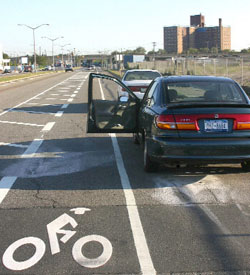Streetsblog Interview: Ryan Russo
Ryan Russo is the New York City Department of Transportation’s Director for Street Management and Safety, a newly-created job that he started in July. Previously, Russo worked as DOT’s Downtown Brooklyn Transportation Coordinator where he was instrumental in designing and developing a number of improvements for pedestrians, cyclists and more livable streets (PDF file) over the last three years. Streetsblog caught up with Russo on Tuesday, a few hours after the City’s big bike safety announcement:
 Streetsblog: The City just released a major bicycle safety study and announced a plan for "unprecedented" bike infrastructure improvements. What does today’s announcement mean for cyclists?
Streetsblog: The City just released a major bicycle safety study and announced a plan for "unprecedented" bike infrastructure improvements. What does today’s announcement mean for cyclists?
Ryan Russo: In the past, we were doing about twenty-five miles of bicycle facilities a year. Right now we are on pace to build forty miles in the current fiscal year (Editor: New York City’s fiscal year starts July 1). Next year we’re going to pick up the pace and build seventy miles. In 2009 we’re going to build ninety miles. So, we are, essentially, quadrupling the output of our bike facilities. That is unprecedented and will create a dramatic change in the city’s bicycle network.
SB: Do you see bike lanes as a critical safety feature on New York City streets? Do they really help make cyclists safer?
RR: I think bike lanes are very helpful. I’m a cyclist myself. I bike to work. I bike for my errands, I don’t own a car and am very bike dependent. In fact, sometimes I bike too often. I don’t want to take the subway and I’ll get stuck in the rain a lot. Bike lanes help with safety in a lot of subtle ways and not-so-subtle ways. For motorists they help create the expectation that they are going to find cyclists on the roadway. And they help to make the movements on the roadway more predictable in terms of where the cyclist is expected to be and where the motorist is expected to be. Bike lanes are also useful for laying out the core network. They help aggregate cyclists onto particular routes so that they all end up on the same street rather than dispersing throughout the network. This helps motorists on those corridors get used to the cyclists. There is a lot more to bike lanes but the bottom line is, yes, I think they are very useful.
SB: So, now I’ve got to ask: What kind of bike do you ride?
RR: Laughing. I ride a model of a Giant bicycle. It’s called the Bowery. It’s a messenger-style bike although I replaced the drop bar with a straight bar because I prefer a more upright position on my bicycle even though it’s less hip.
SB: Does your bike commuting inform your job? Are you riding around the city looking at design issues and thinking, "I’m going to take care of that when I get back to the office?"
Ryan’s bike.
RR: Absolutely. My design perspective and my idea of what makes sense on the streets are informed by my experiences on the road and my interactions with motor vehicles. My learning as a designer evolves and is an iterative process and I’m always looking for opportunities to make improvements.
SB: What is your advice to advocates and community organizations who are working to make New York City’s streets better for cyclists, pedestrians and mass transit users? What would be the most productive way for the Livable Streets Movement to work with DOT?
RR: That’s a really interesting question. The reality on the ground right now is that cyclists are a minority street user. On most corridors cyclists don’t outnumber pedestrians or vehicles. When we install bike lanes we give cyclists a disproportionate percentage or roadway space relative to their numbers. Some communities have had a problem with that given all of the competition there is for different uses of our valuable street space. So, I think that the Livable Streets Movement can help educate people who might see bike lanes as a less-than-worthwhile use of street space.
SB: Other advice?
RR: I’d like to see a more cooperative relationship. I think there’s a lot of opportunity and a lot of common ground in many of the things that we all want to accomplish. So, let’s find that common ground and make things happen.
SB: Towards that end, what are your goals in your new job? What are you trying to accomplish?
RR: I’d like to improve the interconnectedness of the bike network and make sure the network works at key connections like we did on Tillary Street and we’ll be doing on Sands Street in Brooklyn. I’d like to make sure we have good connections to popular bicycling facilities like the Hudson River Greenway, Prospect Park, and Central Park. And obviously, safety is something we’d like to see improve.

Before and After: Tillary Street in front of the federal court, Downtown Brooklyn.

Before and After: The plan for Sands Street beneath the Manhattan Bridge.
SB: In a recent letter to the Times you noted that the City’s plans for bike lanes are sometimes voted down by community boards. Why does DOT even allow community boards to vote on whether to improve important safety measures? Why not treat bike lanes as a kind of non-negotiable design element, like crosswalks?
RR: Well, how do you think we’re going to get 200 miles built in three years!?… Look, what I said in the letter is that we have to work harder to get community board support for these projects which is why I suggested that Livable Streets advocates give us a little hand. At the end of the day the street is ultimately DOT’s purview. But we’re not going to stop working with communities. We’re keeping them in the loop and advising them of our plans and listening to their feedback and we’re going to take it into account. But we’re also going to try to meet our targets and make these improvements to bike facilities. If you want to see how difficult this can be do a background search on the local newspaper articles that were written when we installed bike lanes on the Shore Front Parkway (pictured below) and Commonwealth Boulevard in Queens .
 SB: Those weren’t popular with the community?
SB: Those weren’t popular with the community?
RR: That’s an understatement.
SB: But you went in and put them in anyway?
RR: Yeah. In August.
SB: What kind of complaints do you hear in communities like those when you come in with a bike lane?
RR: If I had to boil it down into three categories of complaints, first there’s the worry that bike lanes might somehow slow down traffic. Second, there are concerns about the impact of double parking during street cleaning operations and the higher fine for a parking ticket in a bike lane. Finally, there are negative perceptions of cyclists themselves.
SB: I know we’ve got to wind up here, so the big question is, do you read Streetsblog? And do you love it?
RR: Laughing. You know, I think there are a lot of people here who read it but I’ve got a new job and I’m very busy with a big commitment to pedestrians and schools and I’m just not finding the time.





